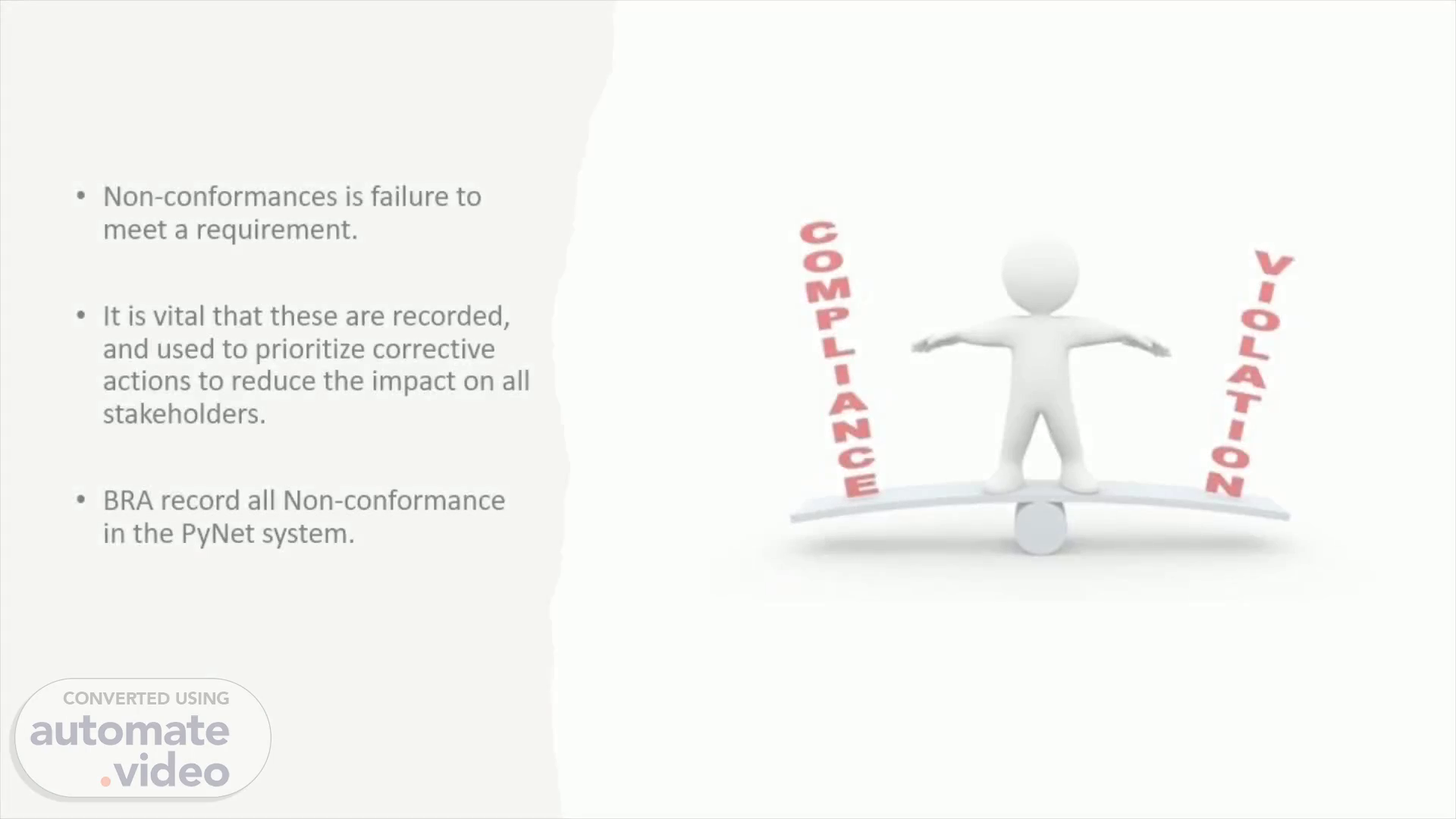
PowerPoint Presentation
Scene 1 (0s)
[Audio] Let's discuss about the Non-conformance Procedure first Non-conformances is failure to meet a requirement. It is important to record the Non-conformance and used to prioritize corrective actions to reduce the impact on all stakeholders. BRA record all Non-conformance in the PyNet system, and I will explain further regarding recording Non-conformance in a later slide..
Scene 2 (26s)
[Audio] Non-conformance classification Non-conformance can be classified in different ways in BRA we used to classify Non-conformance as critical, major, minor and Observation. What is critical non-conformance? Critical Non-conformance is a condition that directly affects the quality of products and regulatory compliance. The condition violates essential rules of the applicable standard and basic quality assurance practices. It is necessary to take Immediate action once you find critical Non-conformance. What is Major non-conformance Major Non-conformance could raise when no process is in place which meets a significant component of a requirement, or the outcome is not effective. The condition violates the rules of the applicable standard and quality assurance practices. In this case we recommend to take actions to avoid these Non-conformance. What is minor non-conformance Minor non-conformance is the requirement not fully met, or the outcome is only partly effective. The condition may not affect the quality of the product or compliance with the applicable standard. Observation is the last category of the Non-conformance classification Observation is a Non-critical lapse in performance or suggestion for improvement..
Scene 3 (1m 55s)
[Audio] Now you have brief understanding about what is the Non-conformances. Here I will give few examples of the Non-conformances that would help you to understand when you need to raise a Non-conformances. Unauthorized change in documentation – Minor Missegregation of non-conforming products– Minor Improper machine calibration– Minor Incorrect sequence of minor processes– Minor Non-critical defects of product packaging– Minor Frequent unauthorised changes in the controlled documents - Major Shipping out of untested products- Major Missing critical documentation- Major Working in unsafe environmental conditions- Major Personnel who failed to take corrective action on a root cause of an issue- Major.
Scene 4 (2m 51s)
[Audio] Non-conformance recording is a vital process in the QMS, and BRA Staff could able to raise Non-conformance through PyNet. If you believe a non-conformance has occurred, please record it in PyNet as below. Click on the Initiate Quality Process Quick Link Select 'Initiate a Non-conformance and complete the required information Include a description and detail the reason you raised the NC (what the requirement "should be" and what it actually "is"). Alternatively, notify the Quality Department in person or via email. The non-conformance will be reviewed by Quality. In this video you can see how to create Non-conformance through PyNet..
Scene 5 (3m 39s)
[Audio] In the Non-conformance process you need to clearly understand about correction, corrective action and preventive action. Correction is a one-time activity of correcting or rectifying a mistake/error. This is the immediate action we have to take once we identify a Non-conformance. In this diagram you can see the correction you can take when you see not significant fire at the workplace. Think we got product return because of the minor dents on drums during the transition. In this case the correction is redrum and relabeling the drums if there is no any product impact. I will take one more example to explain this. Think you have identified incoming raw materials that do not comply with the BRA standard. In this case the immediate action is quarantine the material and isolate until further investigation. Corrective Action is the action taken to eliminate the cause of the mistake/error to prevent it from recurring. This involves understanding the root cause and eliminating it. Let's we take the same example to find this out. In the example 1 we can Identifying the reason for damaging drums during the transition and train people for care handling as corrective action. Example 2; we can strengthen the raw material inspection process for the same supplier and increase the frequency/ sampling the next time for the materials coming from the same supplier. Preventive Action is the action taken to prevent a potential mistake/error before it happens. We can Change the logistic service company, which could be able to do the same task with more care as preventive action in first scenario. In the example 2, we can start to check all other materials more frequently coming from the same supplier and strengthen all other suppliers' raw material acceptance criteria..